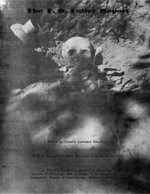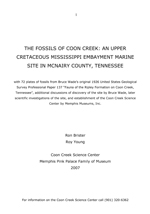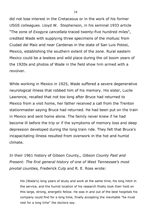|
|
WELCOME TO THE MEMPHIS ARCHAEOLOGICAL AND GEOLOGICAL SOCIETY
Click here for information on how you can become a MAGS member.
Meetings/Field Trips
.......... .......... ..........
2024 Meetings dates and times
ADULT AND YOUTH VISITORS ARE ALWAYS WELCOME AT MAGS MEETINGS.
You must be a member of MAGS to participate in MAGS field trips.
You must be a member of MAGS or another Dixie Mineral Council club to participate in DMC field trips.
IMPORTANT NOTE: Non-members are not permited to participate in any MAGS or DMC field trips.
This includes all areas: public, private collecting, and pay sites. No exceptions.
To learn more about upcoming events and programs,
check out the latest Rockhound News.
HERE'S A VERY IMPORTANT WEBLINK FOR YOU FROM THE TN GEOLOGICAL SURVEY
Click on the image below to learn about Tennessee fossils

•••••••••• •••••••••• ••••••••••
PUBLICATIONS [listed here by permission of each owner] |
T.O. Fuller Excavation |
Coon Creek Fossils: Part 1 |
Coon Creek Fossils: Part 2 |
|
|
|
Lower Devonian Fossils of West Tennessee |
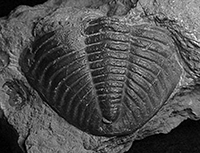
The 50mm-wide specimen represented here is Dalmanites retusus. Known only from isolated pygidia. The pygidium is distinct from other Birdsong trilobites in that it has a rounded profile and lacks a pygidial spine.
|
Excerpt from Devonian Fossils of West Tennessee, by Kieran Davis.
The Lower Devonian system is well represented in Tennessee, forming part of an almost unbroken sequence of deposits ranging in age from the Middle Silurian to upper Lower Devonian. The Ross Formation of west-central Tennessee contains the most diverse and abundant Lower Devonian invertebrate fauna and this guide focuses on the most fossiliferous member of the Ross--the Birdsong Shale. The Birdsong Shale is well exposed in road cuts along State Highway 69 and in the many active and disused quarries of western Tennessee.
Click here or on the trilobite to download your copy of this 40-page PDF. |
| Late Pleistocene Megafauna From Mississippi Plain Gravel Bars |
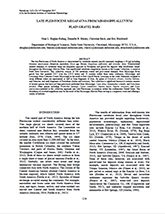 |
Excerpt from Late Pleistocene Megafauna, by Dr. Nina L. Baghai-Riding, Danielle B. Husley, Christine Beck, and Eric Blackwell.
The late Pleistocene of North America is characterized by vertabrate animals (mostly mammals weighing ≥ 44kg) including Mammut americanum (American mastodon), Bison spp. (bison), Megalonyx jeffersonii, and Arctodus simus. Disarticulated skeletal elements of vertebrate fauna are frequently exposed on floodplain and gravel bar deposits after floodwaters retreat throughout the Mississippi Alluvial Plain.
Click here or on the lefthand image to download your copy of this 24-page PDF. |
| Survey of Florida's Invertebrate Marine Fossils |
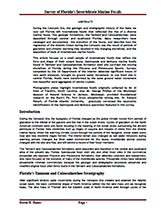 |
During the Cenozoic Era, the geologic and stratigraphic history of the State we
now call Florida left invertebrate fossils that reflected the rise of a diverse
marine fauna. Two geologic formations, the Tamiami and Caloosahatchee, were deposited through central and southwest Florida. Many researchers have
cataloged and documented the evolution of the fauna, and describe how the
regression of the Atlantic Ocean during the Cenozoic was the result of periods of glaciation and climatic warming that resulted in the changing shorelines, and the deposition of beds of invertebrate marine fossils.
This article focuses on a small sample of invertebrate fossils that reflect the
form and shape of their extant fauna.
Click here or on the lefthand image to download your copy of this 14-page PDF. |
•••••••••• •••••••••• ••••••••••
EXPLORE MAGS A LITTLE BIT MORE |
The Earth Wide Open |
Pictures |
MAGS Field Guide |
For information about The Earth Wide Open, the annual Rock Show sponsored by MAGS and held at the AgriCenter in Memphis, TN, click here. |
|
|
|
Click here to visit, ask questions, or leave comments on the MAGS Field Guide to Rocks, Minerals and Fossils. Click here for an index of topics on the blog. |
Chucalissa Indian Village |
|
CHUCALISSA (Choctaw word meaning "Abandoned House"): The ruins of this native American town sit on the Mississippi bluff five miles south of downtown Memphis. At one time the population of Chucalissa could have been a thousand to fifteen hundred. The town existed into the seventeenth century, when its townspeople left and never returned. Hence, the name Chucalissa. Since most native Americans north of the Rio Grande never developed a written language, we can never know the town's real name.
Read about MAGS' involvement in the early years of Chucalissa. |
ON THE WEB
Visit the MAGS Flickr gallery of pictures

MAGS MEMBERS: We have a place to showcase your field trip, rock show, and mineral-collecting vacation pictures. Visit our Flickr gallery of pictures. If you have pictures you would like to share, send them to the MAGS webmaster and [if they are pictures all members of MAGS would enjoy] he will get them in the gallery.
•••••••••• •••••••••• ••••••••
"When out fossil hunting, it is very easy to forget that rather than telling you how the creatures lived, the remains you find indicate only where they became fossilized."
–– Richard E. Leakey
|
|
|


